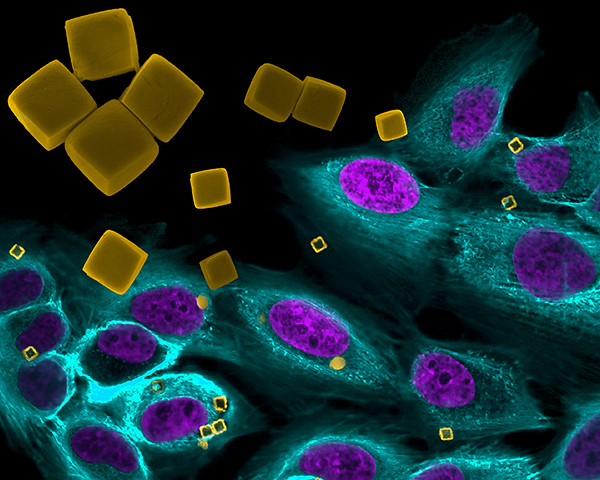Have you ever seen Fantastic Voyage? In the 1966 film, a submarine crew is tasked with repairing a scientist’s brain. To achieve this, they’re shrunk to a microscopic size and injected into the scientist’s body. Granted, the plot is the perfect style for a science-fiction movie. However, it appears that the Richard Fleischer picture was ahead of its time. Over the past decade, the world of longevity has intertwined with technology. In doing so, it’s introduced a style of medicine that may help us live forever – thanks to little agents crawling inside of us. Enter nanomedicine.
What Is Nanomedicine?
Nanomedicine is the medical application of nanotechnology. This is focused on the implementation of incredibly small structures that can improve health and longevity. As indicated by the name nano-, nanometers are incredibly small – one-billionth of a meter to be precise. Now, if the plan is to inject minuscule objects into the human body, it’s best to understand how the immune system and diseases work.
Louis Hawthorne is an entrepreneur with over 27 years of experience in founding and leading companies in biotech, life sciences and information technology, reproductive cloning, human IVF, oncology, and artificial intelligence. Throughout the years, Hawthorne has developed a relentless curiosity about illnesses and medicine,
“I’ve been trying to figure out how diseases work. How do drugs work? Why don’t drugs work better than they do? What does the immune system do?” asks Hawthorne,
“If we have a perfect immune system, why does it sometimes get thwarted by diseases like cancer? So these are the first principles of diseases and drugs and the human condition.”
How do diseases work?
In studying diseases, Hawthorne found that you can categorize diseases into three areas;
- Intracellular diseases: This is related to genetics, and it’s a minority of diseases. Hawthorne details that less than 10% -15% of diseases involve some intracellular abnormality (abnormality inside the cells).
- Inflammatory Diseases: These are caused by excess inflammatory cytokines, with cytokines being the signal molecules of the immune system. Essentially, this is how the immune system talks to itself and non-immune cells.
- Suppressive diseases (inhibitory diseases): This is an abnormal cluster of cells, and the immune system leaves it alone. It’s always because they secrete immune inhibitors and all cancers work this way. All solid tumor cancers cannot survive without their immune inhibitors. They’re grossly abnormal in all the ways the immune system evolved to detect and destroy.
In treating inflammatory and suppressive diseases, the option is often to put in drugs in an attempt to tamp down the cells. However, Hawthorne points out that the cells aren’t the problem. Rather, it’s the signals that the cells are sending out.
Cells and Their Signals
If we wish to understand diseases, the first thing would be to better understand the human body and the immune system. Hawthorne explains that below the level of cells, tissues, and organs, are cells like the atoms of biology, yet there’s a whole system operating below that, which Hawthorne refers to as an informational system,

Louis Hawthorne
“Cells are constantly sending and receiving informational molecules that are a million times smaller than cells.
A lot of times, good cells do bad things when they get bad information from other cells similar to good kids in a bad neighborhood that turn out bad. However, it’s not the kid’s fault. They’re just getting bad information.”
With that said, Hawthorne theorized that treating diseases may be less about adding things to the body, as we’ve done for 2000 years, but by removing bad informational molecules,
“I studied with an inventor in Germany who treats cancer that way,” shares Hawthorne, who adds that, 12 years ago, the German inventor would treat cancer by filtering out tumor-generated immune inhibitors from the blood.
The immune system’s inner workings
As explained by Hawthorne, the immune system acknowledges cancer as a threat and wishes to destroy it. Unfortunately, the tumor would secret immune inhibitors that instruct the immune system to stand down. Ironically, this is a trick that cancer learned from pregnancy as the action is exactly what the fetus does,
“The fetus is only half the mother so the immune system should destroy it as a parasite. Instead, the fetus, through the placenta, secretes immune inhibitors, which are the same ones that cancer uses,” illuminates Hawthorne.
Cancer is a condition that’s an area of interest for Hawthorne is cancer, which touches everyone,
“Cancer took out one of my mentors, a beautiful man, brilliant man, PhD in endocrinology, and when we lost him, I decided I wanted to do something more important with my life and my brain.”
With that, Hawthorne began to explore how to remove the inflammatory signals that drive inflammatory disease. Simple: Leave the cells alone. Now, how can we remove the inhibitory signals that defend tumors? Once again, Hawthorne’s answer is to leave the cells alone,
“Don’t target cancer because cancer cells are so similar to normal cells so when you target cancer or target the immune system to amp it up against it, you cause as many problems as you create.”
With that in mind, Hawthorne sought to adopt subtractive approaches, which led him to phoresis.
Filtered Blood for Better Health
Phoresis focuses on the filtration of blood, outside of the body, such as through dialysis,
“There are much more sophisticated forms of phoresis where you filter the blood using what’s called an affinity column, meaning you’re taking out something very specific from blood,” explains Hawthorne, who adds that this style of phoresis is what connected him with the previously mentioned German scientist,
“I studied with him for a couple of years and he treated cancer by filtering from blood one type of tumor-generated immune inhibitor, very low mass, and everything else went right back into the patient’s body. “
As powerful as this technology is, the downside of phoresis is that it’s very invasive,
“You’re connected to a machine and this machine, to be effective, needs a very high flow rate of your blood through the machine,” says Hawthorne, who further describes that a large bore catheter goes through your aorta, and you also have a surgical port installed,
“You’re then connected to this machine for three or four hours, two or three times a week.”
To ensure tumor regression and prevent tumor progression, the machine needs to remove about 10 millionths of a gram. Now, the idea of a large refrigerator-sized device being used to remove 10 millionths of a gram of immune inhibitors sounds ridiculous, yet thankfully nanomedicine and nanoengineering may achieve this at a much smaller and easier scale.
Nanots to Fight Cancer
“The idea that you could make a nanostructure that would absorb those tumor-generated immune inhibitors seemed feasible. We started doing mathematical modeling, like just trying to envision it in math and software as to whether it was possible. And the math said it was possible.”
With that said, Hawthorne came up with the concept of nanots – virus-sized engineered absorptive particles, and co-founded the company NaNotics.
Speaking on the role of nanots, Hawthorne wants us to understand the concept of immune privilege,
“Immune privilege means an area in the body where the cells are not normal, and yet the immune system leaves it alone. When treating cancer, you’re trying to strip away immune privilege as the tumor has its immune privilege.”
With nanots, Hawthorne and his team are putting particles in, but the particles get cleared by macrophages, which are immune cells that are also the garbage collectors of your blood,
“All we’re doing is taking something out, but we’re doing it in a more efficient way than pharesis. We’ve now demonstrated this several times by depleting two different kinds of tumor-generated immune inhibitors.”
Is This A Cure for Cancer?
Hawthorne revealed that they’ve tested nanots in humanized mice, which are mice with immune systems that are partially converted to human immune systems and tumors that are partially converted to human tumors. He shares that they’ve tested nanotics and they showed that in humanized mice, in collaboration with the Mayo Clinic, the nanotics profoundly suppressed tumors in a mouse model of triple-negative breast cancer, which doesn’t respond to pretty much anything,
“All we did was put these nanoparticles in that absorb a tumor-generated immune inhibitor. We’re not adding a drug. We’re taking something out of blood.”
While chemotherapy and immunotherapy are often the standard for those diagnosed with cancer, Hawthorne reveals that he and his team have dosed rodents at over 100 times the planned dose, and have yet to see any toxicity,
“We haven’t seen any toxicity at our maximum feasible dose…We expect it to be considerably more effective since it already works in animal models where conventional drugs and immunotherapies don’t work.”
So, is it a cure for cancer?
Nanotics may not necessarily cure cancer. However, Hawthorne believes that cancer treatment can be enhanced if medical practitioners first disinhibit the tumor microenvironment,
“If you take out tumor-generated immune inhibitors, anything else you want to do is going to work better at lower doses with lower toxicity, so nanotics are potentially adjunctive to everything else that’s out there.”
That said, Hawthorne admits that you may not necessarily have to do anything else but take out immune inhibitors when diagnosed with cancer. In doing so, you will tilt the battle that’s happening in the tumor microenvironment and see gradual regression, which can then lead to remission.
Tackling the Next Pandemic
Ever since the COVID-19 pandemic, scientists have been working hard to prepare a cure for the next pandemic. Now, it seems that Hawthorne may have identified both the future pandemic and the cure.
“Looking at the most acute of the inflammatory diseases is sepsis, which kills more people each year than heart attacks, strokes, or almost any cancer. Sepsis is not an infection, but it can be triggered by an infection. Rather, it’s an immune system overreaction.”
As we know, the immune system is ready to respond to external infections. It does this because it has to get ahead of pathogen replication. Yes, it’s great that the immune system moves faster than the pathogen. Yet, sometimes the pathogen becomes irrelevant and the immune system spirals out of control, delivering these inflammatory molecules everywhere,
“These inflammatory molecules should normally be delivered focally onto the cell that needs to be destroyed, however, sepsis causes these molecules to be secreted systemically and they cause your organs to shut down and it moves very quickly.”
Hawthorne unpacks how patients can go into a hospital and their immune system overreacts and five days later, they’re dead,
“Happened to my beloved stepfather,” Hawthorne reveals,
“We don’t know what the next pandemic will be. But we know it’ll kill by causing a cytokine storm, which is what sepsis is.”
With that, Hawthorne’s team is developing nanots against major inflammatory cytokines that are common to sepsis,
“The idea is that in the next pandemic or in sepsis that happens from other causes, you don’t have to have a vaccine to save millions of lives.”
Rather, one can just deal with sepsis. If you can get the sepsis (the cytokine storm) under control, then this buys you time while scientists develop the next vaccine for the next pandemic.
A Cure for Aging?
While Hawthorne may view sepsis as the next pandemic, many believe that aging and age-related diseases are the real pandemic. Regardless, Hawthorne believes that it all comes down to the same thing: inflammation,
“There’s real hard science that shows that core mechanisms of aging are driven by the gradual buildup of inflammatory cytokines.”
Hawthorne adds that it’s the same cytokines that are involved in sepsis. This then raises the question of whether sepsis is just vastly accelerated aging or is aging slow-motion sepsis.
Regardless of the answer, Hawthorne reminds us that what is important is slowing down aging. This can be done by keeping the gradual buildup of inflammatory cytokines under control,
“We’re developing nanots to take down inflammatory cytokines at the systemic level, and it’s the same nanots that we would use to treat sepsis.”
About Louis Hawthorne
Lou Hawthorne is the founder and CEO of NaNotics, LLC, and the inventor of the company’s core technology. He is an entrepreneur with 27 years. Lou has experience in founding and leading companies developing new technologies in biotech/life science and information technology. These include reproductive cloning, human IVF, oncology, and artificial intelligence.
In 2002, Lou founded the cloning companies Genetic Savings & Clone and BioArts International and co-founded Viagen, Inc., acquired by Intrexon (XON) in 2014.
In 2014, Lou conceived “NaNots” – which are adsorptive immune modulators – and founded NaNotics LLC. The company is currently developing NaNots for treating cancer, sepsis, autoimmune diseases including MS, and aging, in collaboration with Mayo Clinic and other groups. NaNots have demonstrated near-total tumor suppression in humanized mouse models of cancer, significantly outperforming checkpoint inhibitors. NaNots are the subject of 31 granted patents to date.
Lou has collaborated closely with NaNotics company co-founder, John Dodgson, PhD, a physical chemist and IP expert, for two decades.
He holds a B.A. in English Literature from Princeton University, where he was a University Scholar and recipient of the Ward Mathis Prize.
Watch The Interview
View this post on Instagram
MAIN IMAGE CREDIT: NIH Image Gallery/Flickr
You can also watch more about Louis Hawthorne’s work on nanots:



![women [longevity live]](https://longevitylive.com/wp-content/uploads/2020/01/photo-of-women-walking-down-the-street-1116984-100x100.jpg)










